Mulches: Miracles or Menaces?
Used appropriately mulches help gardeners and the plants that we grow, but they can also hinder our plants. Let’s examine the facts.
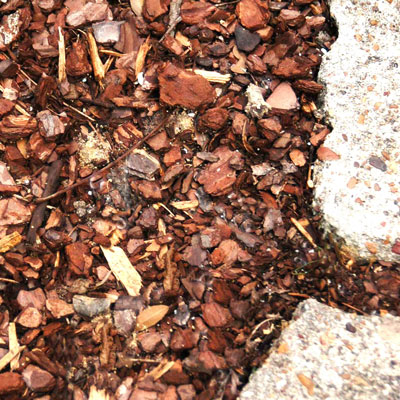
Photo: Bark mulch looks natural, decays to release nutrients back into soil.
What on earth is a mulch?
That’s exactly what a mulch is – a material we use to cover bare soil. They can be organic (bark mulch, compost, dried grass clippings, shredded tree leaves, etc.) or inorganic (gravel, ground rubber tires, even glass, roll-type fabrics, polyethylene, etc.).
Organic mulches decay over time, returning nutrients to the soil. Inorganic types don’t decay, so they’re usually more permanent. Organic mulches look more natural, and they’re not picked up by lawn mower blades and hurled across the yard.
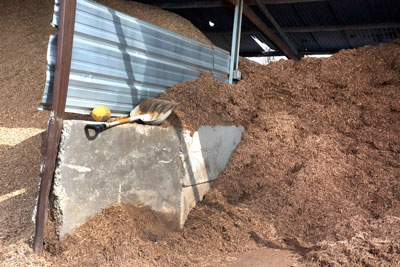
Photo: Major recycling facility turns yard waste into valuable organic compost.
Why do we mulch?
Mulches reduce splashing, so they protect plants against soil-borne diseases that are spread during irrigation and rainfall. They keep soil from splattering the sides of our houses. Homeowners with iron-rich red soils are all too familiar with the stains that splashing can cause.
Mulches moderate the rates at which soil temperatures change in the winter. It’s the freeze-thaw cycles that do damage to plants. We learned as children that if we are at risk of frostbite, we should hold our hands or feet under cool, not warm water, for the very same reason.
However, the main reason most Texans use mulches is to conserve water. Mulches reduce soil-to-air contact. Just as wrapping loaves of bread keeps them from drying out, covering bare ground helps it retain moisture. And, as an added bonus, mulches make it much more difficult for weed seeds to sprout. Weeds are water hogs, so anything that retards their development will also save water.
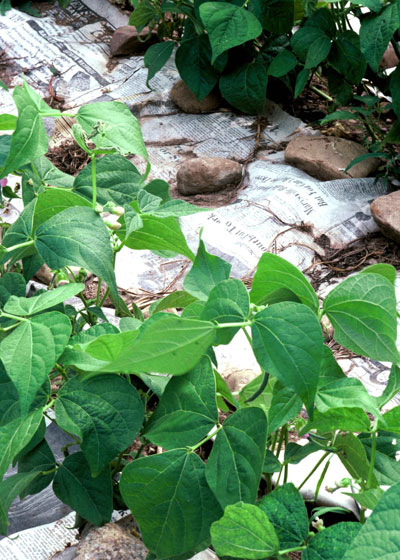
Photo: Newspaper spread over vegetable garden may not look very good, but it does the job in stopping germination of weeds.
Then how can mulches be bad?
It’s not that the mulches themselves are bad. It’s how we use them. As is our custom, we do things to excess. All you really need to add for mulches to perform their magic is 1 to 1-1/2 inches. People pour out layers 3 and 4 inches deep. That much mulch absorbs far too much water and keeps it from getting into the ground.
The same thing happens around young trees. Arborists refer to what they see as “mulch volcanoes.” They’re mounds 8 to 12 inches deep piled up around the trees’ trunks. Every year, more mulch is added. Truth is, those mounds may have gotten their starts when the trees were planted initially. Soils left over in the process, rather than being carried off site, was piled up around the trunks and concealed with mulch.
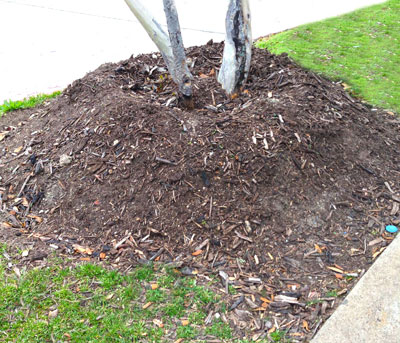
Photo: Huge pile of soil and mulch will greatly inhibit penetration of water to root system of this new tree.
So the problem in all that is that water and nutrients never make it to the root zone. All that organic mulch absorbs water about as quickly as you can apply it. The mulch gets soaked thoroughly, but the ground is often still dry.
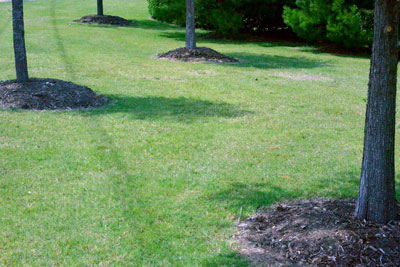
Photo: Established trees are still being maintained with excessive amounts of mulch around their trunks and root flares.
It does need to be noted that some tree-planting crews plant their trees “high” (above the surrounding grade), saying that it will ensure good drainage and aeration in wet times. They go so far as to pile the soil they remove from the holes up around the trunks. Then they conceal it all with the mulch. In reality this procedure is mainly useful for those of you in Southeast Texas, where water tables are often near the soil surface. For most of the rest of the state, except in unusual circumstances of poorly drained sites, it is not a good plan.
